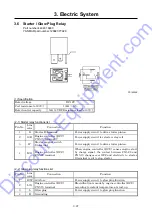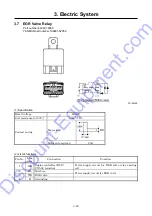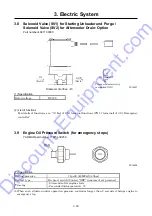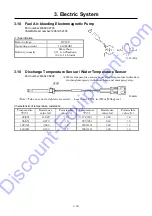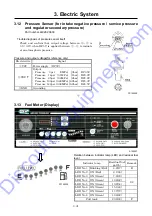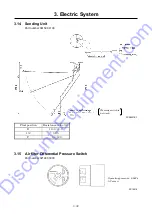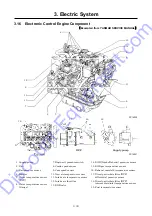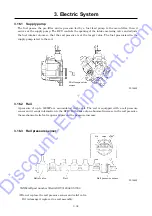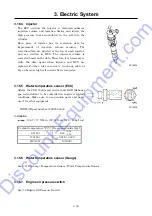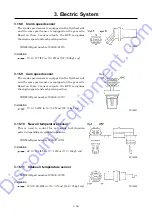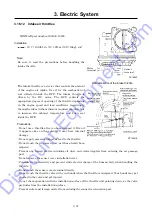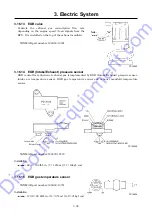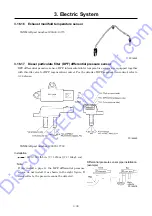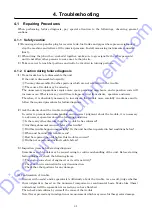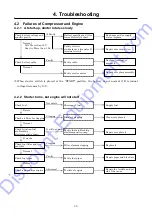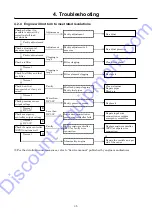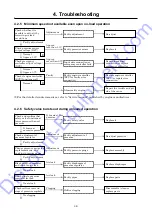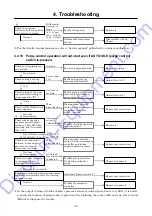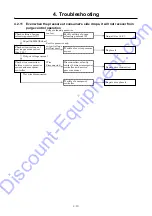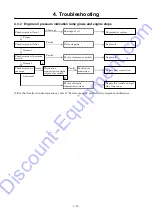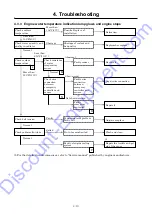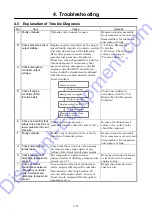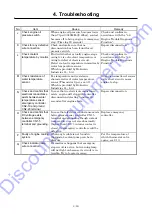
4. Troubleshooting
4-1
4.1
Repairing Procedures
When performing failure diagnosis, pay special attention to the followings, observing general
cautions.
4.1.1
Safety caution
(1) Removing such cap and/or plug for receiver tank, fuel tanks and pipes where pressure is loaded,
stop the machine and relieve all the interior pressure. Install measuring instruments connected
firmly.
(2) When doing the job with co-worker(s) together, make sure to give signal to the other person(s)
and do not allow other persons to come near to the job site.
(3) Take care not to touch hot portions and not to be involved in turning portions.
4.1.2
Caution during failure diagnosis
(1) Do not make haste to disassemble the unit
If the unit is disassembled urgently.
①
You may disassemble the other portions which are not related with the trouble.
②
The cause of trouble may be missing.
The unnecessary reparations require more spare parts and man-hours, and reparation costs will
increase more. What is worse, you will lose reliance or trust from clients
,
operators and users.
Therefore, it is absolutely necessary to investigate the trouble more carefully in advance and to
follow the required procedures for failure diagnosis.
(2) Ask the clients about the trouble in details
In order to prevent misunderstanding and incorrect judgment about the trouble, it is necessary
to ask users or operators about the following questions.
①
Is there any other disorder than the trouble he has informed?
②
Anything abnormal occurred before this trouble?
③
Did this trouble happen unexpectedly? Or the unit had been operated in bad conditions before?
④
When and how did this trouble occur?
⑤
Had he repaired the unit before this trouble occurred?
⑥
Did he not experience similar trouble before?
(3) Inspection items before starting diagnosis
Sometimes such trouble may be caused owing to routine mishandling of the unit. Before starting
failure diagnosis, check the following items.
①
The engine runs short of engine oil or its oil is not dirty?
②
Check each wire connection for any disconnection.
③
Check the other portions for any damage.
(4) Confirmation of trouble
Discuss with user(s) and/or operator(s) sufficiently about the trouble. As a result, judge whether
their judgment is based on the numerical comparison or sentimental basis. Make him (them)
understand well the reparation or correction you have finished.
Then check and confirm by yourself the cause of the trouble.
Note) Never proceed any investigation or measurement which may cause further greater damage.
Discount-Equipment.com
Summary of Contents for PDS185S-6E1
Page 1: ...www discount equipment com D i s c o u n t E q u i p m e n t c o m...
Page 10: ...1 Specification 1 4 Unit mm A131025 D i s c o u n t E q u i p m e n t c o m...
Page 18: ...1 Specification 1 12 1 7 Piping Diagram PC14063E D i s c o u n t E q u i p m e n t c o m...
Page 19: ...1 Specification 1 13 1 8 Fuel Piping PC14001 D i s c o u n t E q u i p m e n t c o m...

